|

Examples
of radon mitigation systems installed by R.H.M.M.
These
are radon mitigation system examples installed over an extended period
by RHMM, with original radon concentrations reported to us shown in
the column with header "Before", and a clearance test done by us
after mitigation based on a short term (2 day) tests that follow EPA
guidelines. The purpose of the clearance test is to present the
completed radon mitigation system to the home owner so they can also
perform their own post mitigation radon test to proof
that the system is working. Since we are an NRPP certified
radon
testing company it is our policy to write a full EPA test report to the
customer of our post mitigation test. This procedure is consistent
with the EPA protocol.
System types:
In the
column with header "Building Type" we indicate whether the house
is a one-story ranch, bi-level, tri-level etc. Tri-level homes
have variations where the lowest and middle floors consists
of either a concrete slab plus a crawlspace (Slab +Crawl), or of two slabs. We also show if
basements are finished or unfinished where relevant. Some additional
remarks can be found on special situations we encountered.
In
some cases we go through 3 finished levels vertically up plus an attic,
this is indicated as "3.5 levels".
Under the
header "System Details" we distinguish when the system
was Interior (fan in attic) versus Exterior (fan outside). Here we also
show the number of branches that were installed on that system.
Finally
under "System Type" we indicate whether the system reaches the
entire footprint with the vacuum produced by the ventilator
(also called the Pressure Field Extension, or PFE) as verified
by
the sub-slab de-pressurization communication (SSDC) test on the day we
do the work. This completes with the caulking of all reachable areas an
EPA system. Therefore this is called a "Complete System". If
a
small section of additional slab, or crawlspace exists that is not
reached with the vacuum, such a system is called an Incomplete, or
Phase I system. Incomplete systems are only installed if they have
shown to work via the Clearance Test, and perpetual continued testing
by the home owner is encouraged to test if they continue to work.
"Ideal
Systems" are systems that have unfinished basements and all
cracks, grooves and openings can be completely caulked and they have a
an interior drain tile pipe on inside of the footer that can be reached.
This is the same as an RRNC-system in new home construction. In
addition we can step up the quality of a regular RRNC to take
better care of energy losses by installing a double barrier under the
concrete slab which are individually fully sealed to the foundation and
footers in new home construction. The latter is called an "Ideal
System" with additional energy efficiency features. These systems are
recommended when the slab has in-floor heating.
The color designation in the
background of each row is emphasizing the following characteristics of
system and home styles:
Green = Existing
homes with radon system that have 1 or 2 Branches.
Red = More complicated systems and/or with 3 or more Branches.
Purple = Ideal Systems.
Blue = Alternative Systems.
Yellow = Passive to Active system conversion.
List with examples of mitigated homes by RHMM:
|
Street
Name |
Before |
After |
Building
Type |
System
Details |
System
Type |
|
|
pCi/L |
pCi/L |
|
|
|
| 1 |
Westview Ave |
53 |
0.9 |
2 story, finished basement+Crawl |
Interior 3 Branch |
Complete System |
| 2 |
Candeleria |
6.9 |
1.2 |
2 story with basement |
Interior 1 Branch |
Complete System |
| 3 |
Shelby Dr. |
5 |
tbd |
Passive to Active conversion |
2.5 stories |
Complete System |
| 4 |
Sedgewick Dr. |
20 |
1.2 |
Ranch |
Interior,
2 Branch |
Complete System |
| 5 |
N. Kennedy Ave. |
4.7 |
0.5 |
tri-level |
Interior,
3 Branch |
Complete
system |
| 6 |
Southern Cross Lane |
4.5 |
1.7 |
Passive to active Conversion |
2.5 stories |
Complete system |
| 7 |
Bianco Dr. |
8 |
1.7 |
Ranch, with Basement |
Interior
1 Branch |
Complete System |
| 8 |
Eastborough Dr. |
9 |
0.6 |
Bi-level |
Interior,
1 Branch |
Complete System |
| 9 |
Montmorency St. |
3.9 |
1.0 |
Ranch |
Interior,
1 Branch |
Ideal System |
| 10 |
Berkshire Dr. |
13.3 |
1.2 |
tri-level
w. 2 Slabs |
Interior,
2 Branch |
Complete
System |
| 11 |
Independence
Rd. |
9.4 |
tbd |
Bsmnt
+ Crawl |
Interior,
2 Branch |
Complete
System |
| 12 |
Loyolla
Avenue |
10 |
0.0 |
Ranch
over Crawl |
Interior,
1 Branch |
Ideal
System |
| 13 |
6th
Place SW |
13 |
1.1 |
Ranch,
Fin. Bsmt. |
Interior,
1 Branch |
Complete
System |
| 14 |
Santa
Fe Ct. |
8 |
2.1 |
Ranch,
Unfin. Bsmt. |
Interior
, 1 Branch |
Complete
System |
| 15 |
Hollyhock
St. |
5 |
1.6 |
Ranch,
Fin. Bsmt |
Interior,
2 Branch |
Complete
System |
| 16 |
Pearl
Creek Dr. |
35 |
2.8 |
2
Story over Crawl |
Exterior,
1 Branch |
Incomplete
Syst. |
| 17 |
Stanley
Circle |
5.8 |
1.3 |
Ranch,
Fin.Bsmnt+Crawl |
Interior,
2 Branch |
Complete
System |
| 18 |
N.
Overland Trail |
N/A |
tbd |
Solved
noise issue System originally installed by others. |
Exterior,
1 Branch |
Incomplete
System |
| 19 |
Meadow
View Pwy |
17 |
2.5 |
2 Story
over Unfin. Bsmnt with wood structural floor |
Interior
1 Branch, 3.5 levels |
Complete
System |
| 20 |
Bayside
Circle |
9.3 |
1.5 |
Town
home over Fin. Bsmnt. |
Interior
1 Branch, 3.5 levels |
Complete
System |
| 21 |
Shadow
Mntn Dr. |
9.6 |
1.0 |
Tri-level
w. two slabs |
Exterior,
2 Branch |
Complete
System |
| 22 |
Copernicus
Dr. |
|
1.1 |
Passive
to Active Conversion |
Interior,
1 Branch |
Complete
System |
| 23 |
White
Pines Dr. |
9.6 |
0.4 |
Ranch
over Crawl |
Interior,
1 Branch |
Ideal
System |
| 24 |
Picadilly
Dr. |
N/A |
tbd |
Fin.
Bsmnt+ Crawl |
Interior,
2 Branch |
Complete
System |
| 25 |
Rangeview
Dr. |
12.7 |
1.7 |
Unfin.
Bsmnt. |
Interior,
1 Branch |
Complete
System |
| 26 |
McClellan
St. |
13 |
1.3 |
Unfin.
Bsmnt + Crawl |
Interior,
2 Branch |
Complete
System |
| 27 |
Animas
Place |
12.6 |
1.2 |
Fin+Unfin+Crawl(2x) |
Interior,
5 Branch |
Complete
System |
| 28 |
Shelburne
Ct. |
9 |
1.9 |
Fin.
Bsmnt + Crawl |
Interior,
2 Branch |
Complete
System |
29
|
Prairy
Ridge Dr. |
12 |
1.9
|
Fin.
Bsmnt + Crawl |
Interior,
2 Branch |
Complete
System |
| 30 |
Phoenix
Dr. |
? |
1.6 |
Fin.
Bsmnt +Cawl |
Interior,
2 Branch |
Complete
System |
| 31 |
Parkhill
Ct. |
9 |
0.9 |
Fin
+ Unfin. Bsmnt |
Interior,
1 Branch |
Complete
System |
| 32 |
Newcastle
Dr. |
6.6 |
1 |
Fin.
Basmnt |
Interior,
1 Branch |
Complete
System |
| 33 |
DesMoines
Dr. |
5.8 |
1.6 |
Unfin.
Bsmnt |
Interior,
1 Branch |
Complete
System |
34
|
Annelise
Way |
? |
0.7 |
Passive
to Active Conversion |
Interior,
1 Branch |
Complete
System |
| 35 |
CR
23 |
29.2 |
0.5 |
Unfin.
Bsmnt |
Exterior,
1 Branch |
Complete
System |
| 36 |
37
St. |
12 |
0.7 |
2x
Crawl. |
Interior,
1 Branch |
Ideal
System |
37
|
Parkhill
Ct. |
9.3 |
1.4 |
Passive
to Active Conversion |
1
Branch |
Complete
System |
38
|
Jackson
Ave. |
9.7 |
0.5 |
Ranch
on Grade |
Interior,
6 Branch |
Complete
System |
| 39 |
Sand
Dollar Dr. |
9 |
1.7 |
Unfin.
Bsmnt. |
Passive
to Active, 1 Branch |
Complete
System |
| 40 |
Guardian
Peak Dr. |
8.5 |
3.8 |
Fin.
Bsmnt + Crawl |
Exterior,
3 Branch |
Complete
System |
41
|
Langdale
Dr. |
27 |
2.2 |
Fin.
Bsmnt |
Exterior,
1 Branch |
Complete
System |
| 42 |
Golf
View Way |
12 |
0.9 |
Fin
Bsmnt |
2
x Exterior, 5 Branch |
Complete
System |
| 43 |
N.
Sheridan Ave. |
13.9 |
0.4 |
Bsmnt
+ Crawl |
Exterior,
2 Branch |
Complete
System |
44
|
Blackwood
Dr. |
13 |
2.1 |
Unfin
Bsmnt |
Interior,
1 Branch |
Complete
System |
45
|
Eric
St. |
8.3 |
0.9 |
Ranch
on Grade |
Interior,
1 Branch |
Complete
System |
| 46 |
Iowa
Ave. |
24.3 |
1.0 |
Fin+
Unfin. Bsmnt |
Interior,
3 Branch |
Complete
System |
| 47 |
Rossum
Dr. |
16.2 |
0.7 |
Fin
Bsmnt |
Passive
to Active |
Complete
System |
48
|
Onyx
Place |
? |
1.5 |
Unfin
Bsmnt |
Interior,
1 Branch |
Complete
System |
| 49 |
Crestview
Dr. |
? |
1.2 |
Unfin
Bsmnt |
Interior,
1 Branch |
Complete
System |
50
|
Ridgeway
Dr. |
15.2 |
1.0 |
Fin+unfin
Bsmnt |
Interior,
2 Branch |
Complete
System |
| 51 |
Lindenview
Ct. |
4.9 |
1.2 |
Fin
Bsmnt |
Interior,
2
Branch |
Complete
System |
| 52 |
Monaco
Pl. |
7.9 |
2.1 |
Fin.
Bsmnt |
Exterior,
1 Branch |
Complete
System |
| 53 |
Mohawk
St. |
13 |
1.6 |
Fin.
Bsmnt |
Interior,
3 Branch |
Complete
System |
| 54 |
Cottonwood
Circ |
14.5 |
0.7 |
Fin.
Bsmnt |
2
x Interior,
3 Branch |
Complete
System |
55
|
Stuart
St. |
19.5 |
2.0 |
Fin.
Bsmnt |
Interior,
2 Branch |
Complete
System |
56
|
Grand
Canyon St. |
4.2 |
1.6 |
Fin
Bsmnt + Crawl |
Exterior,
2 Branch |
Complete
System |
57
|
Rollingwood
Lane |
11.2 |
0.9 |
Fin
+ 4 x Crawl |
Exterior
SLN,
5 Branch |
Complete
System |
| 58 |
Fish
Creek |
N/A |
|
RRNC
+
Low ENERGY Loss |
Interior,
1 Branch |
Ideal
Energy Eff. |
59
|
McGraw
Rnch Rd |
N/A |
tbd |
RRNC
+ Heated Slab+Crawl
Low ENERGY Loss |
Interior,
2 Branch |
Ideal
Energy Eff. |
60
|
Animas
Place |
29 |
2.8 |
Fin
+ Unfin. Bsmnt |
Interior,
4 Branch |
Complete
System |
| 61 |
Critter
Ct. |
? |
0.5 |
Crawl |
Interior,
1 Branch |
Ideal
System |
62
|
Kiva |
7.8 |
2.0 |
Ceremonial
House + Tunnel + Tower |
ERV |
ERV |
63
|
Alta
Vista Dr. |
7.8 |
1.3 |
Unfin
Bsmnt + |
Exterior,
2 Branch |
Complete
System |
64
|
Preserve
Dr. |
N/A |
|
RRNC |
Interior,
1 Branch |
Ideal
System |
65
|
Taft
Hill Dr. |
8 |
|
Ranch
with wood lifted floor + Crawl |
Interior,
2 Branch |
Complete
System |
66
|
Miwok |
175 |
|
Unfin.
|
Interior,
1 Branch |
Complete
System |
| 67 |
|
660 |
3.5 |
Ranch
with Finished Bsmnt |
Exterior
SLN,
2 Branch |
Complete
System |
Radon
Concentration distribution BEFORE radon mitigation systems were
installed
The hystogram below of data from before
2001,
shows that roughly three out of four homes that were not tested for
radon can expect to have a radon concentration larger than the EPA
level in the lowest lived in area in our local region near Fort Collins
CO.
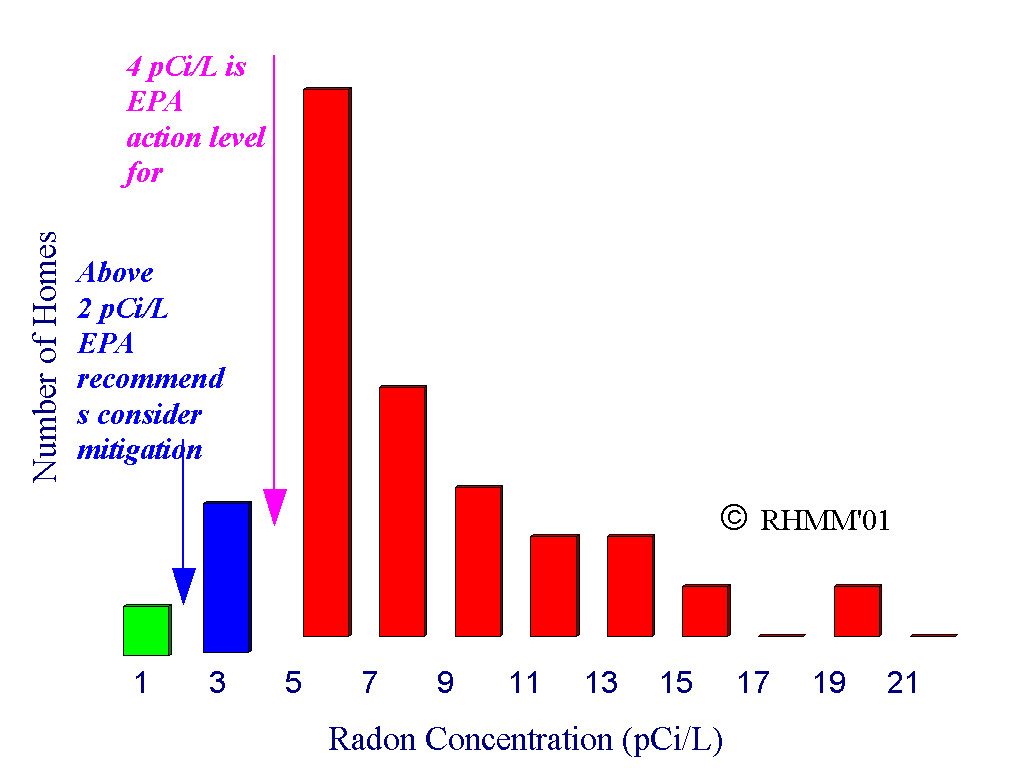
Radon Concentration
distribution measured AFTER radon mitigation was completed.
An artists rendering based on the real data that
we had
measured after radon mitigation was completed shows a
frequency
distribution strongly peaked under 2.0 pCi/L, but that we cannot
exclude finding radon levels up to 4 pCi/L occasionally. This can be
understood if we take all sources of radon into account that are not
only from below the slab, but also from above the slab, and also
sources that have to do with variability of the weather and connections
to the soil cavities are taken into account. Colorado has Karst and
Karst like areas that contribute to the latter resulting effect. What
also contributes is that a long term (one year long) test may show
lower radon presence in the house due to the open conditions
that exists during part of the time as opposed to all short term tests below, that were done within
a few days after the mitigation in a two-day test period with closed house
conditions that followed EPA guidelines. Therefore the
post-mitigation testing distribution may be somewhat skewed towards the higher values. However
these are the values that were measured. All systems
were quality systems. Phase 1 (incomplte) systems
that had
original values at or over 4.0 pCi/L were always finished
with
Phase 2, causing them to have a level below 4.0 pCi/L, and in effect
moving them into the "Complete System" category.
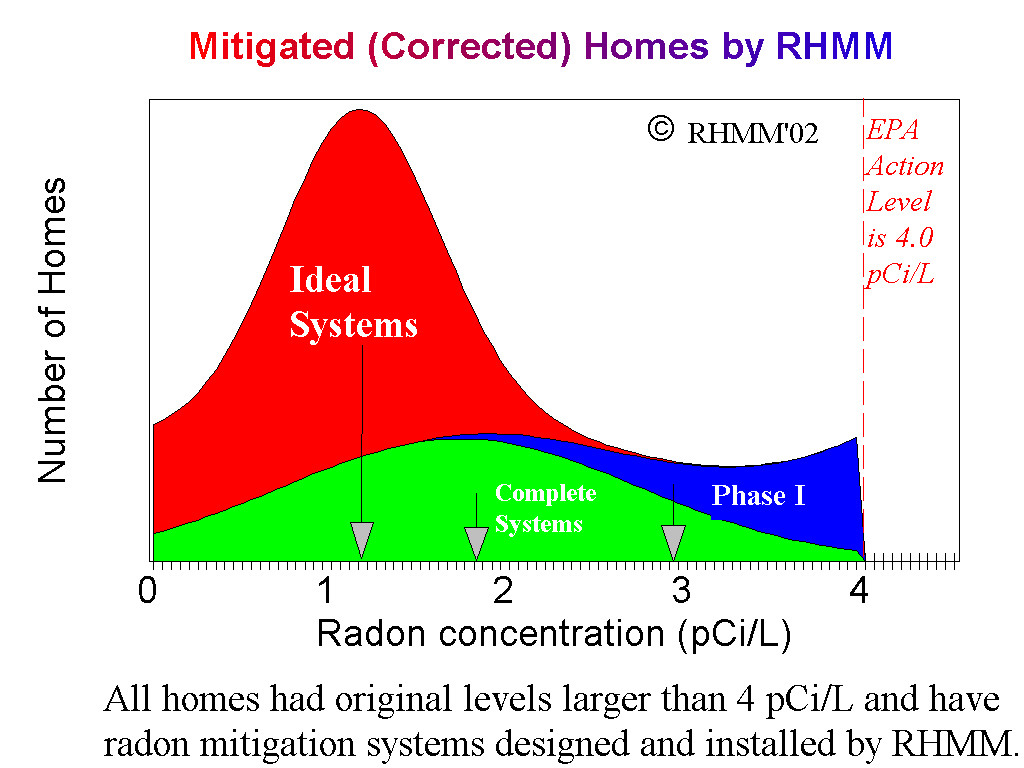
Hourly distribution of radon concentrations as a function of time AFTER we installed a radon
mitigation
system in a home with 57 pCi/L before the mitigation.
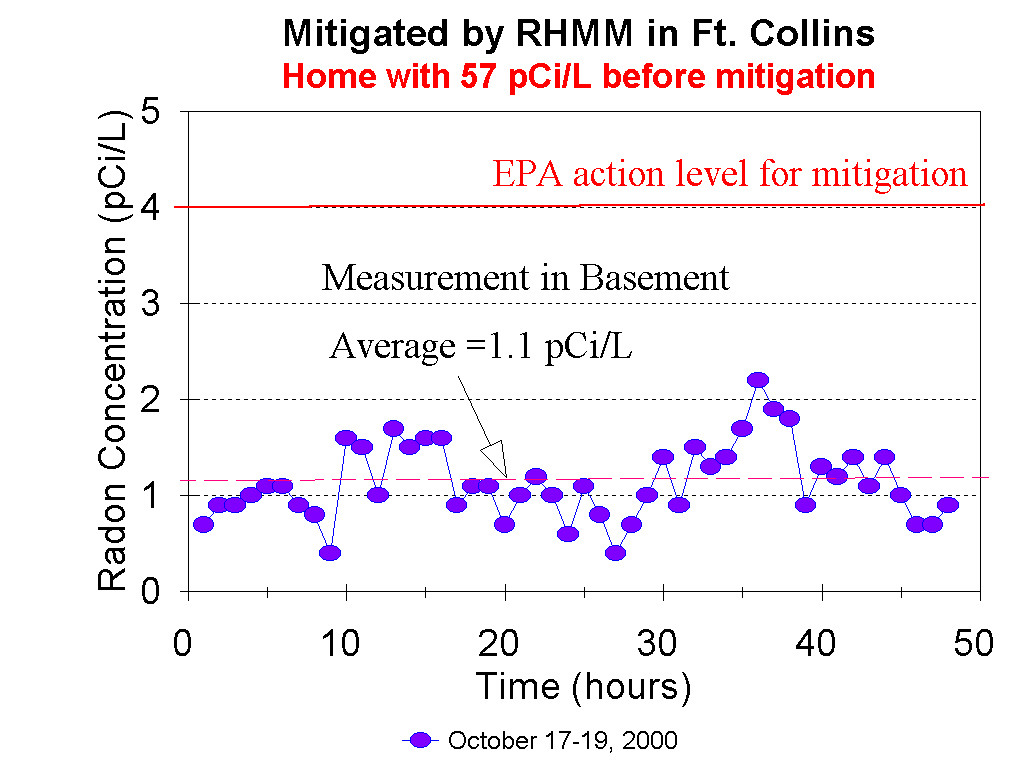
These are only examples as
every house is different and an optimal solution can be found depending
on the many details of your house. The first three examples are also
called Active Soil Depressurization (ASD) systems and are based on the
principle that the radon is captured under a radon barrier -- The
barrier consists of the concrete basement slab that is hermetically
sealed, or an impermeable barrier to be installed in a crawlspace --
and guided via a vent pipe to above the roofline using an active
element in the form of a powerful, yet low noise in-line ventilator.
The fourth example is based on an entirely different principle as
explained. The fifth example shows how a crawlspace looks after the
radon barrier is installed.
1:
Interior Radon Mitigation System
In the case of an Interior System the pipe can be shielded from the
outside view and noise can be kept away from interior finished areas.
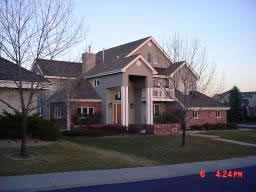 In the
first picture the ventilator is in the attic of this home. The vent
pipe is here only visible as a small speck on the roof. The pipe
routing went from unfinished basement into the kitchen pantry (backside
wall) into the masterbedroom closet (along backside wall) into the
attic and through the woodshake roof. The ventilator was placed in the
attic immediately under the roof as shown in the next picture. In the
first picture the ventilator is in the attic of this home. The vent
pipe is here only visible as a small speck on the roof. The pipe
routing went from unfinished basement into the kitchen pantry (backside
wall) into the masterbedroom closet (along backside wall) into the
attic and through the woodshake roof. The ventilator was placed in the
attic immediately under the roof as shown in the next picture.
Interior System: Ventilator
and pipe optimally shielded from the view, outside and inside.
Or
the pipe can vent hidden through back side of garage roof 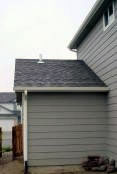
 Example how the
ventilator can be placed in the attic of the home. Example how the
ventilator can be placed in the attic of the home.
2:
Exterior Radon Mitigation System
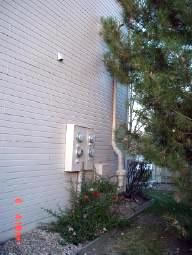 |
An Exterior Radon Mitigation System has the
ventilator on the outside of the home, preferably out of view from
street side and back sitting area because of visual and noise concerns.
These systems are not less effective in removing the radon than
interior systems but often allow a more cost effective approach at the
cost of the visual and noise impact of the system on the outside of the
house.
Exterior System: More
visible from the outside and somewhat more noisy than an interior system
|
3:
Super-Low-Noise Exterior Radon Mitigation System
|
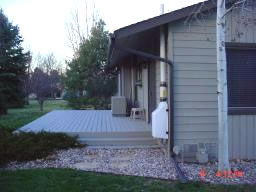
Click
photo to see more pictures.
|
This system was
developed by us for one of our customers. The noise that the
conventional exterior system (see example 2 above) made bothered her
next to the sitting area on the deck. The conventional exterior system
was inherited from the seller in the real estate transaction. The
current home owner requested to transform the system in a radon
mitigation system that gives the lowest-noise-possible. This became our
"Super-Low-Noise" option.
Super Low Noise
Exterior System: Minimizes noise in case the system has to be placed
outside near a deck or sitting area.
|
4:
Energy Recovery and Ventilation Radon Mitigation System
|
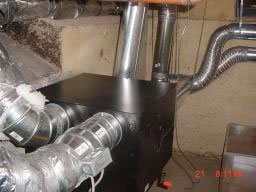
Energy Recovery
& Ventilation System
|
In the case of an
Energy Recovery and Ventilation systems the principle of the mitigation
is different from the conventional systems discussed above: A dilution
of radon concentration is caused by constantly bringing in fresh air
and removing stale air from basement or whole house. This is a good
option if the building also benefits from fresh air circulation, such
as in older buildings, buildings with odors in basement, or
inaccessibly low crawlspaces ("engineered", suspended wood floors in
basements, with a crawlspace equal or less than 2 feet high). Another
example is when the basement or area is used as office and there are
not a lot of windows and the area can use fresh air summer and winter.
|
5:
Crawlspace Radon Removal System
|
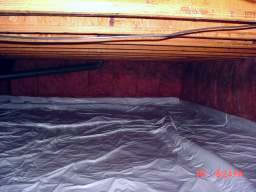
Click
photo to see more pictures.
|
In the case of a 4
foot high crawlspace in your home a conventional radon mitigation
system (ASD) is installed (any one of the examples 1 through 3) in
combination with a collector system under this white special radon
barrier (black plastic is not a radon barrier) as is shown in various
pictures.
|
In the case of a 4 foot
high crawlspace in your home a conventional radon mitigation system
(ASD) is installed (any one of the examples 1 through 3) in combination
with a collector system under this white special radon barrier (black
plastic is not a radon barrier) as is shown in various pictures (click
photo for more pictures).
Radon Mitigation
Why use RHMM for
your radon mitigation needs:
 A fully certified person by
the National Environmental Health Association (NEHA) will do the Radon
Mitigation. A fully certified person by
the National Environmental Health Association (NEHA) will do the Radon
Mitigation.
 EPA
standards and procedures will be followed. EPA
standards and procedures will be followed.
 We have
mitigated all types of homes including: We have
mitigated all types of homes including:
- Two story
homes with finished and unfinished basements.
- Ranch with full
finished and unfinished basements, and crawlspace.
- Tri-level homes with
partial crawlspace.
- New and Old homes.
- Businesses and
commercial properties
 Typically we obtain results
below 1.5 pCi/L after our mitigation is done. Typically we obtain results
below 1.5 pCi/L after our mitigation is done.
 We work
professionally and clean. After the mitigation work is over, apart from
a system that is installed appropriately hidden in your home, there is
hardly any tell tale signal that we worked in your home. We work
professionally and clean. After the mitigation work is over, apart from
a system that is installed appropriately hidden in your home, there is
hardly any tell tale signal that we worked in your home.
 Our systems
are always designed to incorporate your wants and needs in them: Our systems
are always designed to incorporate your wants and needs in them:
- We will find the best
solution
- We will find a solution
with the least visible changes to your home, so you do not have to worry
about loss of value and extra stress when reselling your home.
- Sometimes we will be
able to propose a very economical solution depending on the special
configuration of your home. This is why we want to personally visit
your home to inspect
whether there are such possibilities that are still consistent with the
EPA-standards.
<<
back to top
<< Previous
[Radon Measurements] Next
[Real Estate Transactions] >> Next
[Real Estate Transactions] >>
|















